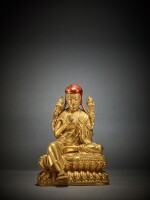
Property From the Estate of Raymond Cheven
A Gilt Copper Alloy Figure of A Sakya Lama, Tibet, 17th Century
Auction Closed
September 20, 05:33 PM GMT
Estimate
26,000 - 36,000 USD
Lot Details
Description
Property From the Estate of Raymond Cheven
A Gilt Copper Alloy Figure of A Sakya Lama
Tibet, 17th Century
Height 6¼ in. (16.5 cm)
the lama seated in lalitasana with the pendent right leg resting on a lotus flower, wearing the red hat of the Sakya sect and clothed in draping robes of a monastic, his hands turning out in dharmakchakra mudra with the stems of lotus flowers held between the thumb and forefingers, the blossoms at each shoulder supporting a sword and sutra
Himalayan Art Resources item no. 13775.
Among his many philosophical and scholarly achievements, Sakya Pandita Kunga Gyaltsen (1182-1251) is perhaps most well-known for the relationship he established with the Mongolian ruling class through the court of the Koden Khan (1206-1251). After a three-year journey to Mongolia, the alliance between Sakya Pandita and Koden Khan proved useful in its role in setting the ground for the priest-patron relationship between Tibet and their powerful foreign neighbors as well as setting the precedent for linking political and religious authority in Tibet.
In this portrait, Sakya Pandita is depicted on a narrow style lotus base. Prominent beading along the upper and lower parts of the pedestal embellished with slender petals is reminiscent of Yongle style bronzes. The loose folds of cloth draping over the legs as the lama sits in the posture of royal ease, with the pendent leg on a lotus, is also evocative of Yongle bronzes. Examples of the fifteenth century style which markedly influenced this portrait are illustrated in U. von Schroeder, Buddhist Sculptures in Tibet, Hong Kong, 2001, Vol. II, pp. 1286-87, pls. 361A-C.
You May Also Like










